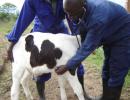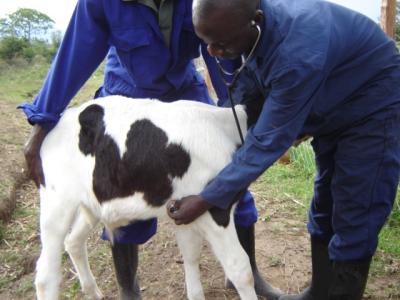
|
Assisting with birth
Common names:
Birth, parturition
Description:
Management disease
|
Introduction
Birth in livestock is a natural process and normally does not need any human interference. But sometimes there can be birth problems where the dam needs assistance from the farmer/pastoralist.
The normal birth
Signs of approaching birth:
1. During the last day(s) before birth there is an increasing soft swelling of the skin (edema) on the udder and in front the udder
2. A few hours before birth the pregnant animal becomes restless, the animal may lie down and stand up again frequently
3. The ligaments at both sides of the base of the tail sink in
4. The vulva swells up
5. Make sure the animal is in a clean and quiet place to give birth
6. Thick mucous is discharged from the vulva
7. Now is the time to prepare yourself: have clean water, soap and two clean ropes ready (ropes should be boiled in water before)
Monitoring birth progress:
1. Labour starts, normally while the animal is lying down
2. Labour in cattle normally takes around 3 hours, but can take much longer with first-calving heifers; in sheep/goat labour is much shorter (about 30minutes)
3. It is important to observe when the water breaks, from this moment on the delivery of the calf/lamb/kid begins
4. Labour comes in repeated intervals until the two feet of the calf/lamb/kid appear
5. In most cases calf/lamb/kid are born with the head between the two front feet coming first, but they can also be born with hind-legs and tail coming first
6. The normal position of the calf/lamb/kid inside the mother is with the back facing up and the belly facing down
7. Now observe until the calf/lamb/kid has been fully delivered
Taking care after birth and providing colostrum:
1. Make sure the calf/lamb/kid starts to breath immediately after birth.
2. If the calf is slow in starting to breath you can clear mucous from the calf's nose and rub the calf to stimulate it
3. It is good to show the calf to the mother by placing it near her head
4. The navel of the calf should be disinfected by dipping it in iodine
5. When the calf starts to stand up you should assist it to suckle, this helps with expulsion of the afterbirth
6. The calf should suckle for he first time not later then 3 hours after birth, the first milk produced by the dam is very thick and yellow and is called colostrum; this colostrum transfers immunity from the mother to the young which protects the calf/lamb/kid during the first 3 to 6months - it is good to feed a lot of colostrum to the calf/lamb/kid, they need to receive minimum 10% of their birth weight(!), colostrum must be given within the first 12 hours after birth, if the calf/lamb/kid receives colostrum too late immunity is very weak and they may die easily.
7. Colostrum also activates movement of the intestine and helps with passing of the first faeces
8. In cattle expulsion of the afterbirth is normally complete 2 hours after birth
Things NOT to do when the animal is giving birth
Many people interfere with birth too early or when it is unnecessary causing more harm than good.
1. Do not chase or cause stress to the animal before and during birth, making the dam nervous can disrupt labour and delay birth by many hours
2. Do not interfere before the water has broken; as long as the water has not broken the calf/lamb/kid will stay alive inside the mother for a long time (up to 12 hours)
3. If birth progresses normally do not attempt to pull, unnecessary pulling can easily cause injury to the newborn and the mother
4. When the animal relaxes do not try to pull out the calf/lamb/kid by force, labour happens at intervals and you are not supposed to pull when the mother rests; hard pulling on the calf/lamb/kid can easily cause prolapse of the uterus which frequently causes death of both, the mother and the young
5. If the afterbirth does not come out normally do not try to put your hands in and don't try to pull it out, you will cause damage to the uterus and may easily infect yourself with Brucellosis by touching the placenta
When to assist with a difficult birth
1. After the water has broken birth must progress, if the mother keeps pressing but there is no visible progress and she becomes tired you must check the position of the calf/lamb/kid.
2. If the position of the calf/lamb/kid is normal but the mother is tired you may assist by pulling gently on the two legs of the calf/lamb/kid, but only pull when the mother is pressing herself; also make sure you have washed your hands before assisting
3. If birth takes long the vulva surface becomes too dry and it is good to apply some foam from bar-soap or from liquid soap onto the surface
4. If you are not sure about how to check the position call an experienced person or a veterinarian
5. If the afterbirth is retained wait for 12 hours then call a veterinarian to treat the animal; if a retained afterbirth is not treated it can cause severe infection of the mother and lead to death or infertility

 Back
Back
